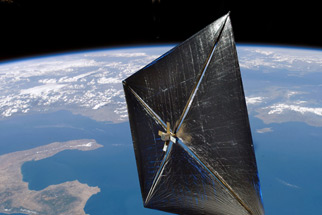Solar Sails
- By David Levin
- Posted 02.03.11
- NOVA
Some future spacecraft may not be propelled by rockets. If NASA engineer Dean Alhorn has his way, they'll be powered by solar sails—big silver kites in space that are pushed along by the sun's rays.
 Listen
Listen
NASA engineer Dean Alhorn says that some future spacecraft may be propelled by the sun's rays.
Editor's Note: Hours after NOVA recorded this interview on January 20, 2011, NASA succeeded in deploying its first solar sail in low-Earth orbit.
Transcript
Solar Sails
Posted February 3, 2011
DAVID LEVIN: You're listening to a NOVA podcast. I'm David Levin.
The next generation of spacecraft will travel faster than ever before. But they might not be propelled by rockets. If Dean Alhorn has his way, they'll be powered by light.
Alhorn is an engineer at NASA's Marshall Space Flight Center. He designs solar sails. Those are basically big silver kites in space that are pushed along by the sun's rays. And Alhorn says they might change spaceflight in the very near future.
So Dean, first of all, how can light actually push anything?
DEAN ALHORN: Well, light, you know, you wouldn't think light has any mass or any momentum. But light actually does have particles called photons. They have very little mass, but they have very high speed. When they travel through space and they were to hit something, they would push on whatever surface that they hit. You don't feel that here on the Earth, but up in space, let's say you have a large sail, and you have lots of these photons hitting it, then you'll generate lots of thrust.
DAVID LEVIN: But why not just use a rocket if they've been reliable in the past? What's the big advantage of a solar sail?
DEAN ALHORN: Ah. Good question. If you have a rocket, let's just think the solid rocket of the space shuttle—you turn it on, it goes, and it's burning up fuel, and then when it's done, that's as fast as you're ever gonna go. Once your fuel is used up, you just coast. And unless you have more fuel to turn yourself, wherever you're going, you're heading right straight there. A solar sail, on the other hand, will slowly accelerate over a long period of time, but then it doesn't run out of fuel. Once you have it out there, as long as there is sunlight, it can move around in space.
DAVID LEVIN: How long does it take for a solar sail to move from one place to another? Seems like it'd take a lot longer than a conventional rocket.
DEAN ALHORN: It takes a while. Because what happens is that a solar sail generates thrust about point two millimeters a second squared. That's a very slow thrust, such that it would take 10 seconds to go two millimeters. So it takes a lot of time. But the nice thing is that, with solar sails, you get thrust continually. You get it 24 hours a day, 7 days a week, 52 weeks a year. It's continual thrust, so that you can go faster and faster and faster.
DAVID LEVIN: So assuming it's going out full-tilt, how fast could it actually go?
DEAN ALHORN: If we were to do some sort of deep space mission, a solar sail vehicle would start out really slow because the thrust is really slow, but over time it would pick up speed, and it would get to where Voyager is at the edge of the solar system in about 10 years. The Voyager spacecraft took about 30 years to get to where it is right now, so you can see that the speed is much faster than a conventional rocket would be at that point, because your thrust is continuous.
DAVID LEVIN: Are solar sails mostly going to be used for long-range missions like that, or could they have other uses closer to Earth?
DEAN ALHORN: There are several different uses and missions that solar sails are prime for. You could use it to basically hover over a point on the Earth. It would basically sit there and monitor for instance the ozone layer over the Antarctic. Or it's possible to hover over, say, the United States, and take pictures all over the United States. One of the nice things about solar sails is if you wanted to move from point to point, it doesn't run out of fuel. We have satellites that can move around, but once their thrust is used up—their fuel, then they're useless. A solar sail can move from one point to another point, say, if it's over the earth and it needs to go over and, say, look at the Gulf during the Gulf oil spill, you could take your time and move it over to the gulf oil, and provide key resources such as communications and/or pictures for that area, depending upon where you need that information at that time.
DAVID LEVIN: Has anyone successfully tested a solar sail?
DEAN ALHORN: Well, the Planetary Society in 2005 launched their first one, called Cosmos 1. Unfortunately, due to a rocket failure, it never made it to orbit. Now NASA, back in 2008 launched one called NanoSail-D. And it was unfortunately lost on the Falcon 1 launch failure. Now, more recently, in June or July of last year, the Japanese deployed their solar sail, and it was called Icarus. And it is on a mission that's heading toward Venus. So they actually deployed the first solar sail in space.
DAVID LEVIN: How new is this technology? Were solar sails even possible 10 years ago?
DEAN ALHORN: It's really brand new. Because it's sort of a convergence of technologies. We didn't have the sail material before. The sail is made of a space-age material called CP-1. It is a very strong plastic, it's like Saran Wrap, and then you coat one side of it with a very thin coating of aluminum. This material is so thin, it's about 10-40 times thinner than a human hair. But it lasts for a long time in space.
The actual components that make up satellites have been getting smaller and smaller. Electronics have become smaller. So therefore now we have the capability to do a lot in a smaller space with less weight, and as you drive the weight down, now you can start driving the size of the sail down.
DAVID LEVIN: What are some of the big challenges of trying to put a solar sail in space?
DEAN ALHORN: The first big challenge is to get the public to accept it. It's not something that—It's basically on the cusp of being accepted in general. You have to design a system which is very hard to test here on the ground, because these structures are very, very lightweight. There's a term called "gossamer"—they're very flimsy, they're very lightweight, and they're very hard to test. That's one of the main challenges. Another challenge is to design it such that it will go off and do what you want it to do, because these materials are sort of thin and flimsy that it takes special mechanisms to make them behave the way you want them to. So it's a challenging mechanical design.
DAVID LEVIN: Dean, thanks again for speaking with me.
DEAN ALHORN: You're welcome!
Credits
Audio
- Produced by
- David Levin
Image
- (solar sail)
- Courtesy NASA
Related Links
-

Plasma Rockets
With a "small sun" for an engine, a new rocket might be able to zip us to Mars and back in under three months.
-

Can We Make It to Mars?
See new space suits, foods, and rockets that may support future Mars-bound astronauts, and meet a Mars rover driver.
-

The Psychology of Spaceflight
NASA psychologist Al Holland says that a three-year return trip to Mars would be a mental challenge for any astronaut.
-

A Mission To Mars
Former astronaut Buzz Aldrin says that a human presence on Mars is inevitable.
You need the Flash Player plug-in to view this content.

